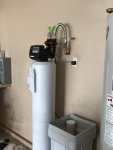- May 23, 2015
- 25,667
- Pool Size
- 16000
- Surface
- Plaster
- Chlorine
- Salt Water Generator
- SWG Type
- Pentair Intellichlor IC-60
So this morning, before the mercury hit 100F, the autofill line was dug up -

Yikes...a little too close to the gas line for my comfort

The water softener is a double tank system - the top tank is a GAC (granular activated carbon) prefilter (chlorine/chloramine/VOC eliminator) and the lower tank is a 54k grain 10% crosslinked ion exchange resin. Control valve is a Clack valve.

The system will be plumbed (all copper & brass) into the house 1” main service loop with a line run out from the garage to the pool autofill line. There will be separate 1/4 turn shutoff valves to isolate either the house plumbing (vacation mode) or the pool autofill or both.

Still debating potassium chloride versus sodium chloride but it’s really not that important ( no renal conditions for anyone in the family). Sodium chloride is obviously the cheaper expense.
Once the pool is on a steady diet of softener water, I’ll start exchanging water in the pool with fresh water to get my CH down slowly. I have a series of flow meters I’ll be using on my submersible pump and hose bib to exchange water from the deep end while filling through the skimmer. Example -


My goal is to spend a few weeks during the summer doing a series of large volume partial drains to get the CH down. It will use more water to do it this way but I’ve run out of time and with the hot weather here and the kids swimming, there’s just no way to fully drain the pool safely or in such a way that doesn’t cause a green swamp to form.
Once the CH is corrected, the water softener will eliminate large drains in the future. Also, managing a balanced CSI is a lot easier with less acid use when the CH is below 400ppm.

Yikes...a little too close to the gas line for my comfort

The water softener is a double tank system - the top tank is a GAC (granular activated carbon) prefilter (chlorine/chloramine/VOC eliminator) and the lower tank is a 54k grain 10% crosslinked ion exchange resin. Control valve is a Clack valve.

The system will be plumbed (all copper & brass) into the house 1” main service loop with a line run out from the garage to the pool autofill line. There will be separate 1/4 turn shutoff valves to isolate either the house plumbing (vacation mode) or the pool autofill or both.

Still debating potassium chloride versus sodium chloride but it’s really not that important ( no renal conditions for anyone in the family). Sodium chloride is obviously the cheaper expense.
Once the pool is on a steady diet of softener water, I’ll start exchanging water in the pool with fresh water to get my CH down slowly. I have a series of flow meters I’ll be using on my submersible pump and hose bib to exchange water from the deep end while filling through the skimmer. Example -


My goal is to spend a few weeks during the summer doing a series of large volume partial drains to get the CH down. It will use more water to do it this way but I’ve run out of time and with the hot weather here and the kids swimming, there’s just no way to fully drain the pool safely or in such a way that doesn’t cause a green swamp to form.
Once the CH is corrected, the water softener will eliminate large drains in the future. Also, managing a balanced CSI is a lot easier with less acid use when the CH is below 400ppm.









 Give yourself a day off.
Give yourself a day off.  ) so he threw back a cold water and I dropped a Sam Adams Summer Ale.
) so he threw back a cold water and I dropped a Sam Adams Summer Ale.